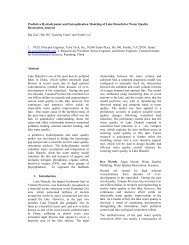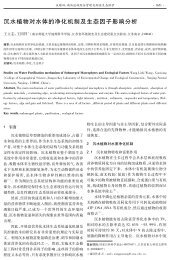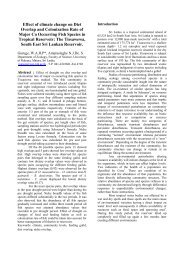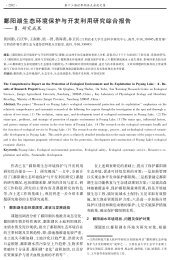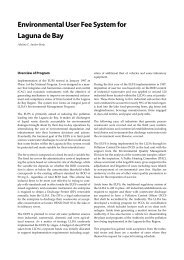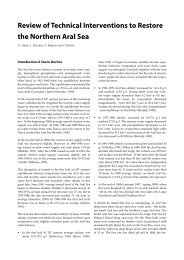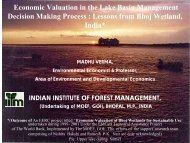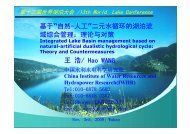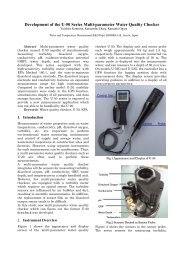Assessment of water quality and quantity of Lake Nakuru, Kenya
Assessment of water quality and quantity of Lake Nakuru, Kenya
Assessment of water quality and quantity of Lake Nakuru, Kenya
Create successful ePaper yourself
Turn your PDF publications into a flip-book with our unique Google optimized e-Paper software.
1.9 meters. The preliminary <strong>water</strong> balance model is afirst attempt at underst<strong>and</strong>ing the lakes <strong>water</strong> budget.Better data (ground <strong>water</strong> recharge, rainfall <strong>and</strong> riverflow) should be used to re-calibrate the Water Balancemodel before a final <strong>water</strong> balance model can bedeveloped.3.2 Abbreviation <strong>and</strong> acronymsWTW-Wisesens-chaftlich Technische WerkstättenWeiheim, (Germany).DO-Dissolved OxygenWWF-World Wide Fund for Nature3.3. AcknowledgmentI wish to thank the management <strong>of</strong> the WWF <strong>and</strong> theDarwin Initiative for financing the study.3.4. ConclusionTo improve <strong>and</strong> maintain surface flows <strong>and</strong> <strong>water</strong> <strong>quality</strong>in the catchment, more information needs to be generatedon the status <strong>of</strong> <strong>water</strong> resources, with particular emphasison the current rates <strong>of</strong> utilization <strong>and</strong> the rate <strong>of</strong>replenishment <strong>and</strong> other changes that may affect theavailability <strong>and</strong> <strong>quality</strong> <strong>of</strong> <strong>water</strong>. . There is also need toestablish a framework for integration <strong>of</strong> sound <strong>and</strong>sustainable practices in resource management <strong>and</strong>development with regard to initiating programmesaimed at improving <strong>and</strong> maintaining <strong>water</strong> <strong>quality</strong> <strong>and</strong>balance in the catchment basin. A GIS database Manualfor Water Pollution & Hydrological Analysis Modulesdeveloped recently by JICA, if properly used, will helpin the calculation <strong>of</strong> pollution load, <strong>water</strong> <strong>quality</strong>, riverdischarge <strong>and</strong> lake levels.3.5 References1) Beasley Val, Aiyasami S.S, Motelin G., Pesier A.P.,Codd, G.A., Nelson M,N., Maddox C.W.,Carmichael W.W., Anderson M.D., Sileo L., KockR.A., Cooper J.E., Franson, J.C., Cooper W.E.,Kilewo, M.K., Mlengeya, T.K., Manyibe, T., RuizM.O(2006). Mass Die-<strong>of</strong>fs <strong>of</strong> Lesser Flamingo(Phoeniconaias minor) in East <strong>and</strong> Southern Africa.Current Knowledge <strong>and</strong> Priorities for Research.Manuscript No. 7017 submitted to the Journal <strong>of</strong>Wildlife Diseases.2) Tuite, C.H. (1978). The lesser flamingo (P. minorGe<strong>of</strong>froy) Aspects <strong>of</strong> its ecology <strong>and</strong> Behaviour inthe Eastern Rift Valley <strong>Lake</strong> <strong>of</strong> <strong>Kenya</strong> <strong>and</strong> NorthernTanzania, a Ph.D. thesis submitted to the Univ.Bristol.3) Harper D.M, R. Brooks Childress, Mauren, M.Harper, Rosalind R. Boar, Phil Hickley, Susanne C.Mills, Nickson Otieno, Tony Drane, EkkehardVareschi, Oliver Nasirwa, Wanjiru E. Mwatha,Joanna P.E.C. Darlington & Xiavier Escute’-Gasulla ( 2003). Aquatic biodiversity <strong>and</strong> salinelakes: <strong>Lake</strong> Bogoria national Reserve, <strong>Kenya</strong>. K.Martens (ed.) Aquatic Biodiversity. KluwerAcademic Publishers, Netherl<strong>and</strong>s.4) Childress B., Harper D., Hughes B., Bossche W.,Berthold P., Querner U. (2004). Satellite trackingLesser Flamingo movements in the Rift Valley, EastAfrica: pilot study report. Ostrich, 2004, 75(1&2):57-65.5) Ballot A., Krienitz, L., Kotut, K., Wieg<strong>and</strong>, C.,Metcalf, S. J., Codd, G.A., Pflugmacher, S. (2004).Cyanobacteria <strong>and</strong> cyanobacterial toxins in threealkaline Rift Valley lakes <strong>of</strong> <strong>Kenya</strong>-<strong>Lake</strong>s Bogoria,<strong>Nakuru</strong> <strong>and</strong> Elementeita.6) Japan Bank for International Cooperation (JBIC)(2002b) Final report for special assistance forproject sustainability (SAPS II) for Greater <strong>Nakuru</strong><strong>water</strong> supply project in the republic <strong>of</strong> <strong>Kenya</strong>. JapanBank for International Cooperation, Tokyo, Japan.7) Ballot, A.,L., Krienitz, Kotut, C. Wieg<strong>and</strong>, J.S.Metcalf, G.A. Codd, <strong>and</strong> S. Pflugmacher,2004.Cyanobacteria <strong>and</strong> cyanobacterial toxins in threealkaline Rift Valley lakes <strong>of</strong> <strong>Kenya</strong>-<strong>Lake</strong>s Bogoria,<strong>Nakuru</strong> <strong>and</strong> Elmenteita. Journal <strong>of</strong> PlanktonResearch 26:925-935.8) ILEC (2005). Managing <strong>Lake</strong>s <strong>and</strong> their Basins forSustainable Use. A Report for <strong>Lake</strong> Basin Managers<strong>and</strong> Stakeholders. International <strong>Lake</strong> EnvironmentCommittee Foundation: Kusatsu, Japan.9) JICA (1994). <strong>Nakuru</strong> Sewage Works Rehabilitation<strong>and</strong> Expansion Project Feasibility Study FinalReport.10) JICA (2002). Final Report for Special Assistance forProject Sustainability II.11) <strong>Kenya</strong> Wildlife Service (2002). <strong>Lake</strong> <strong>Nakuru</strong>Integrated Ecosystem Management plan 2002- 2012.Plan developed in collaboration with Netherl<strong>and</strong>sGovernment, KWS, MCN, WWF, Moi University,<strong>and</strong> University <strong>of</strong> Nairobi.12) American Public Health Association, AmericanWater Works Association, <strong>and</strong> Water PollutionControl Federation.1995. St<strong>and</strong>ard Methods for theExamination <strong>of</strong> Water <strong>and</strong> Waste<strong>water</strong>, 19 th ed.American Public Health Association, Washington,DC.6



